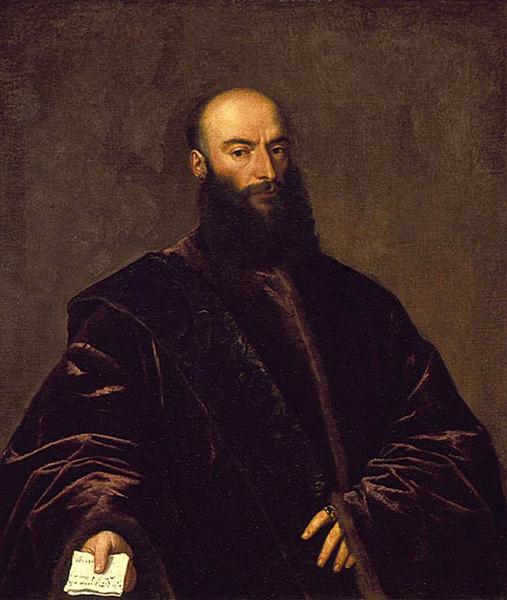Tanım
The "Portrait of Jacopo (Giacomo) Dolfin", painted by Titian in 1532, is a remarkable example of the mastery of the Venetian artist, who was noted for his ability to capture the essence and dignity of his subjects. In this work, Dolfin is presented with an imposing bearing and a gaze that conveys both strength and introspection. The composition is classical in its format, focusing on the character with a very subtle background that allows the main figure to stand out. Dolfin's presence is accentuated by the use of color and light, characteristics that make Titian a pioneer of Renaissance portraiture.
The figure of Dolfin is presented wearing a rich black velvet cloak, while a white shirt peeks out from his collar, which not only signals his social status but also creates a contrast between the dark and light hues. This use of colour is not accidental, but reveals Titian’s mastery of creating depth and texture. The cloak, carefully rendered, seems to move and almost come to life under the artist’s lively palette. The choice of black can be interpreted as a symbol of gravity and solemnity, framing the subject in an aura of respect and seriousness, which was undoubtedly intentional in the context of his time.
Dolfin’s face, with its well-groomed beard and serene expression, is painted in exquisite detail. The eyes, which seem to follow the viewer, communicate a sense of connection that transcends time. This is a characteristic trait of Titian, who often managed to make his portraits serve not only as mere physical representations, but also encapsulate the personality and psychology of his subjects. Jacopo Dolfin’s gaze is penetrating, revealing an active mind and a complex personality – just what one would expect from a member of the Venetian nobility.
An interesting aspect of this portrait is its historical context: Dolfin was an important official and nobleman in Venice, which adds a layer of enigma to the artist's intention. Titian, in choosing to portray him, probably sought not only to document the image of an influential man, but also to establish a connection between art and the political power of his time. Throughout the Renaissance, many artists dedicated themselves to portraying the most prominent figures in society, and Titian established himself as one of the most sought-after in this genre.
Titian's loose, rich brushstroke technique is evident in his depiction of the texture of Dolfin's fabric and skin. These elements, together with a plasticity that brings the figure to life, have led many art critics to regard this portrait as a high point in the development of portraiture. Furthermore, the way Titian uses light, illuminating Dolfin's face and hands, highlights his figure and focuses the viewer's attention on the face and expression of the man portrayed.
When looking at this work, it is evident that Titian was not only a portraitist, but also a visual storyteller. His ability to ground the psychology and identity of the subject through a harmonious and well-thought-out composition is a display of the Renaissance at its best. The “Portrait of Jacopo (Giacomo) Dolfin” thus serves not only as a simple image of a Venetian nobleman, but also as a window into an understanding of individuality at a time when history was undergoing significant change. Titian, through his portraits, offers a reflection on humanity, power, and beauty, with this work being an enduring testament to his artistic genius.
KUADROS ©, a famous painting on your wall.
Hand-made oil painting reproductions, with the quality of professional artists and the distinctive seal of KUADROS ©.
Painting reproduction service with satisfaction guarantee. If you are not completely satisfied with the replica of your painting, we will refund 100% of your money.

